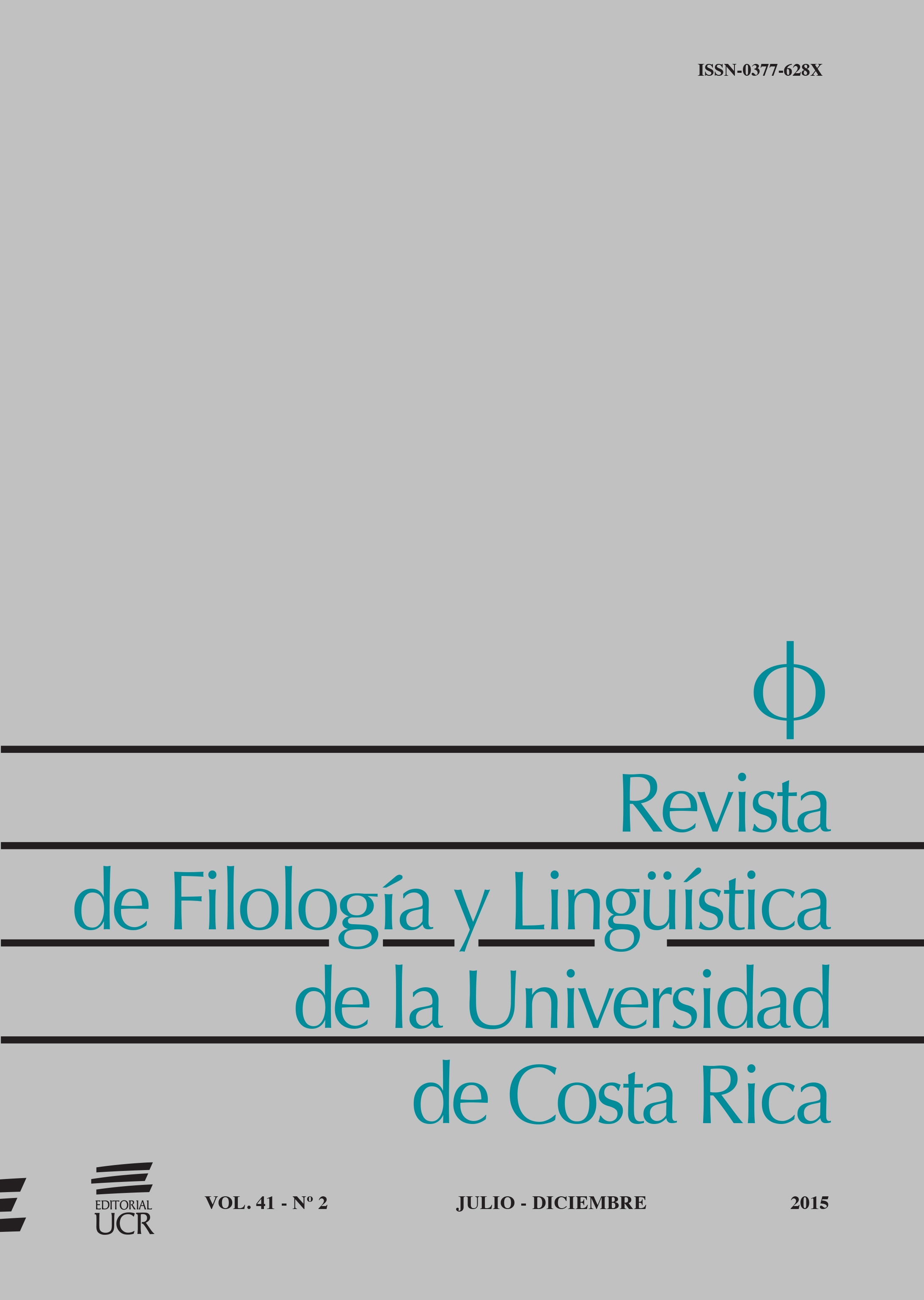Abstract
The following article analyses headings according to the schema of verbal communication proposed by Jakobson. Headings are statements produced by a newspaper, the addresser, and they convey a message related to a reality, whether physical or mental, to the addressee, the reader. In the case of the newspapers La Nación and La Extra, the code is Spanish, but they differ in the selected subcodes: while La Nación is characterized by a formal register, in La Extra an informal style is preferred. Moreover, it is assumed that the functions of language of Jakobson that should prevail are referential and phatic, but in the sports section, in both types of newspaper, some headlines could be related to the poetic function. This implies more freedom in this section to interact with the content of the message. Nevertheless, in La Extra, there were some headings containing either the emotive, conative, or metalinguistic function as the predominant one. In those cases, the purpose is interacting with the reader, incorporating subjective traits, and using language games to make the heading more appealing, so that it can accomplish the objective of attracting and entertaining the reader.
References
Alarcos-Llorach, E. (1973). “El lenguaje de los titulares”. Por F. Lázaro-Carreter (Comp.). Lenguaje en periodismo escrito. (125-147). Madrid: Fundación Juan March.
Berger, P.L. (1981). Para una teoría sociológica de la religión. Barcelona: Kairós.
Bermúdez, M. (1990). La Extra: ¿Representación de las clases populares? Revista de Ciencias Sociales. 47, 55-65.
Bustos, G. (2004-2005). Ciencia y tecnología en la prensa escrita costarricense: análisis de casos. Revista de Ciencias Sociales. 106 (4) – 107 (1), 215-229.
Calsamiglia, H. y Tusón, A. (2008). Las cosas del decir. Manual de análisis del discurso. Barcelona: Ariel.
Colombo, F. (1997). Últimas noticias sobre el periodismo. Barcelona: Anagrama.
Cuvardic, D. y Vargas, E. (2010). Recursos lingüísticos en la titulación periodística costarricense: el caso de La Nación y el diario La Extra. Revista de Filología y Lingüística de la Universidad de Costa Rica. 36 (1), 207-232.
Fonseca, K. (2005). Noticias de sucesos y criminalidad: de los textos periodísticos a la recepción empírica. (Tesis de Licenciatura en Ciencias de la Comunicación). Universidad de Costa Rica.
García-Barrientos, J.L. (2000). Las figuras retóricas. El lenguaje literario 2. Madrid: Alarcos.
González, M.J. (2002). La incidencia de la dimensión contextual en la producción del título periodístico. Atlantis, Revista de la Asociación Española de estudios Anglo- Norteamericanos. 24 (2), 329-48.
González, M. J. (2006). Complejidad del grupo nominal en la descripción y diferenciación de variedades del lenguaje: un estudio de estilística. Revista de Lingüística Teórica y Aplicada. 44 (2), 29-46.
Grupo Nación. (2014). Estudio de medios. http://www.nacionmediakit.com/contenido/. [Consulta 15 de abril de 2014].
Gutiérrez-Ordóñez, S. (2000). Temas, remas, focos, tópicos y comentarios. Madrid: Arco.
Hernando, L.A. (1994). Comunicación y lenguaje en el periodismo escrito. Didáctica, Revista de la Universidad Complutense de Madrid. 6, 145-159.
Hernando, L.A. (2000). Discurso periodístico. Madrid: Editorial Verbum.
Hernando, L.A. (2002). Sobre la configuración lingüística del mensaje periodístico. Estudios sobre el mensaje periodístico. 8, 261-274.
Jakobson, R. (1984). Lingüística y poética. Ensayos de lingüística general. (347-395). Barcelona: Ariel.
Lázaro-Carreter, F. (Comp.). (1973). Lenguaje en periodismo escrito. Madrid: Fundación Juan March.
Martini, S. (2000). Periodismo, noticia y noticiabilidad. Barcelona: Norma.
Martini, S. y Luchessi, L. (2004). Los que hacen la noticia. Periodismo, información y poder. Buenos Aires: Biblos.
Maybin, J. y Swann, J. (2007). Everyday Creativity in Language: Textuality, Contextuality, and Critique. Applied Linguistics. 28 (4), 497-517.
Pano, A. (2012). Funciones metalingüísticas y dobles lecturas del código: estudio introductorio de F. Lázaro-Carreter. Por A. Cassol et ál. (Eds.). Metalinguaggi e metatesti. Lingua, letteratura e traduzione, XXIV Congresso AISPI (23-26 maggio 2007). Padova. (607- 616).
Plett, H. (Ed.) (1991). Intertextuality. Berlín-Nueva York: Walter de Gruyter. Real Academia Española. (2010). Manual de la nueva gramática de la lengua española. México: Espasa.
Samiolo, S. (2008). Semantic Styles in the British Daily Press: A Corpus Study. (Tesi di dottoratoin Scienze Linguistiche, Filologiche e Letterarie). Università degli Studi di Pavoda.
Sánchez, J.F. (1990). Títulos y titulares. Sobre las funciones de la titulación periodística. Comunicación y Sociedad. 3 (1 y 2), 173-183.
Secanella, P. (1981). El lid, fórmula inicial de la noticia. Barcelona: Editorial ATE.
Sunkel, G. (2002). La prensa sensacionalista y los sectores populares. Bogotá: Editorial Norma.
Tusón-Valls, J. (2003). Introducción al lenguaje. Barcelona: Ariel.
Valeri, M.J. (2010). Los sufijos apreciativos -ito, -ico y -ón en cartas escritas en Mérida colonial. Lingua Americana. 14 (26), 15-33.
Van-Dijk, T. (1996). La noticia como discurso. Barcelona: Paidós.
Vargas, E. (2012). La metafunción textual en los titulares periodísticos costarricenses. (Tesis de Maestría Académica en Lingüística). Universidad de Costa Rica.
Vigara-Tauste, A.M. (1992). Función metalingüística y uso del lenguaje. Epos, Revista de Filología de Madrid. 8, 123-141.
Zorrilla-Barroso, J. M. (1996). El titular de la noticia. (Tesis doctoral). Universidad Complutense de Madrid.
Waugh, L. (1980). The Poetic Function in the Theory of Roman Jakobson. Poetics Today. 2(la), 57-82.
